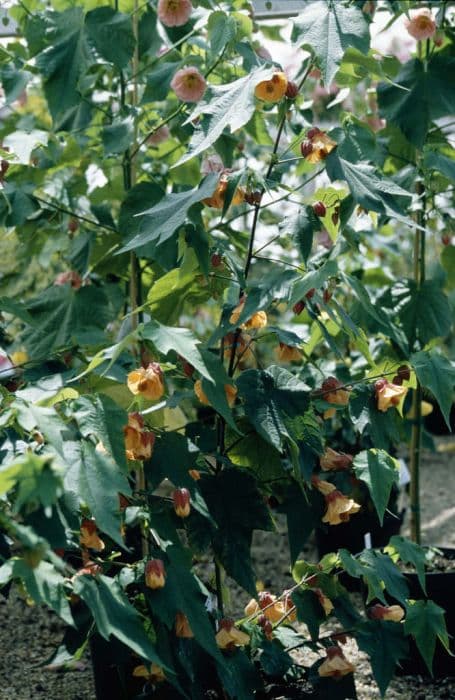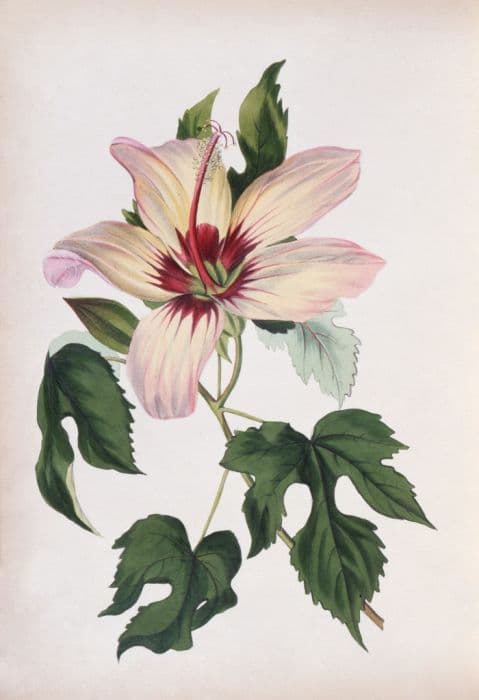Hibiscus Hibiscus 'Eruption'

ABOUT
The Hibiscus 'Eruption' is a strikingly beautiful flowering plant, known for its vibrant and showy blooms. The most eye-catching feature of this hibiscus variety is its large, trumpet-shaped flowers, which exhibit a vivid and fiery blend of colors, often seen in a stunning gradient from yellow at the base, transitioning to rich pink or red shades with a bold crimson center, reminiscent of a lava flow, which likely inspired the name 'Eruption'. Each flower is adorned with a prominent and elongated central stamen, adding to its exotic appeal. The plant's blossoms can be substantial in size, making them a spectacular showpiece in any garden setting. The glossy, deep green leaves contrast with the bright flowers, creating a lush backdrop that accentuates the floral display. The foliage has a slightly toothed edge and is often heart-shaped or oval, contributing a rich, dense canopy that supports the overall aesthetics of the plant. The Hibiscus 'Eruption' typically blooms repeatedly throughout the warmer months, providing a long-lasting and dynamic exhibition of color. On any given day during its blooming period, the plant can have several blooms, each unfurling for just a day before making way for new flowers to take center stage. Overall, the Hibiscus 'Eruption' is a captivating and robust ornamental cultivar that draws attention not only for its stunning flowers but also for the lush, vigorous foliage that complements its dramatic floral outbursts.
About this plant
 Names
NamesSynonyms
Eruption Hardy Hibiscus, Eruption Rose Mallow
Common names
Hibiscus 'Eruption'.
 Toxicity
ToxicityTo humans
The Hibiscus 'Eruption', commonly known as Hibiscus, is not considered toxic to humans. Generally, hibiscus species are regarded as safe for human consumption, and some parts are even used in teas and edible products. However, consuming large quantities could potentially cause stomach upset due to the plant's natural acids and other compounds. But usually, there is no serious toxicity associated with the hibiscus plant, and accidental ingestion typically does not result in poisoning symptoms. Always exercise caution and consult a healthcare provider or a poison control center if consumption occurs and there is concern for health effects.
To pets
The Hibiscus 'Eruption', commonly referred to as Hibiscus, is known to have low toxicity in pets. Some pets, particularly dogs and cats, may experience mild gastrointestinal upset, such as vomiting or diarrhea, if they ingest parts of the hibiscus plant. These symptoms are usually not severe and often resolve on their own. However, different animals can react differently to plants, and what is mildly toxic to one may be more so to another. If a pet ingests a significant amount of hibiscus and shows signs of distress, it is advised to contact a veterinarian promptly.
 Characteristics
CharacteristicsLife cycle
Perennials
Foliage type
Deciduous
Color of leaves
Green
Flower color
Red
Height
4-6 feet (1.2-1.8 meters)
Spread
4-6 feet (1.2-1.8 meters)
Plant type
Shrub
Hardiness zones
5-9
Native area
Asia
Benefits
 General Benefits
General Benefits- Attractive Blooms: The Hibiscus 'Eruption' is known for its large, vibrant flowers that can be a focal point in any garden.
- Drought Tolerance: Once established, it requires minimal watering, making it an excellent choice for water-wise landscapes.
- Heat Resistance: This plant thrives in hot conditions, making it suitable for warm climates and sunny locations.
- Habitat for Wildlife: It attracts pollinators such as butterflies and hummingbirds, contributing to the local ecosystem.
- Easy Maintenance: Hibiscus 'Eruption' generally requires little care beyond occasional pruning and feeding, which can be appealing for busy gardeners.
- Fast Growth: The plant can grow quickly, providing a rapid sense of achievement and change in the garden landscape.
- Versatility: It can be grown in the ground or in containers, offering flexibility for gardeners with limited space.
 Medical Properties
Medical Properties- This plant is not used for medical purposes.
 Air-purifying Qualities
Air-purifying QualitiesThis plant is not specifically known for air purifying qualities.
 Other Uses
Other Uses- Ink Production: The vibrant petals of Hibiscus 'Eruption' can be used to create natural dyes, which are suitable for making inks for arts and crafts.
- Edible Delicacies: The colorful blossoms can be candied or crystallized and used as decorative and edible elements in desserts or cocktails.
- Eco-friendly Fabric Dye: The flowers provide a source of natural dye which can be used in textile industries for dyeing fabrics sustainably.
- Livestock Feed: In some cultures, the hibiscus plant is used as a feed supplement for livestock, providing essential nutrients.
- Fiber Material: The stems of the Hibiscus 'Eruption' can be processed to extract fibers that are used for making ropes or paper products.
- Flavor Infusions: The hibiscus petals can be used to infuse spirits, such as vodka or rum, with a floral flavor and a deep red hue.
- Shoe Polish: The petals, when processed into a paste, can be used as a natural polish that can shine and add color to leather goods.
- Culinary Garnish: Fresh or dried Hibiscus 'Eruption' flowers add an attractive garnish and a touch of flavor to salads and entrees.
- Photography Prop: With its stunning appearance, the Hibiscus 'Eruption' flower can be used by photographers as a prop for botanical and still life photography.
- Holiday Decorations: The flowers and leaves can be fashioned into wreaths and garlands for decorative purposes during festivals and celebrations.
Interesting Facts
 Feng Shui
Feng ShuiThe Hibiscus is not used in Feng Shui practice.
 Zodiac Sign Compitability
Zodiac Sign CompitabilityThe Hibiscus is not used in astrology practice.
 Plant Symbolism
Plant Symbolism- Delicate Beauty: The hibiscus flower is often associated with delicate beauty due to its large, vivid blooms and graceful form.
- Femininity: Its soft and colorful petals are reminiscent of qualities traditionally attributed to women, making it a symbol of femininity and beauty.
- Warmth and Hospitality: In some cultures, the hibiscus is a symbol of warmth and hospitality, welcoming guests with its open and inviting appearance.
- Exoticness: Hibiscus flowers can represent the exotic or the unusual, as they're often found in tropical climates and have a unique look.
- Enjoyment of Life: With its bold colors and lush appearance, the hibiscus embodies a sense of joy and encourages one to enjoy life's pleasures.
- Perfect Love: In some traditions, such as in North Africa, the hibiscus can be a symbol of the perfect woman or a perfect love.
- Carpe Diem: The flower can remind one to seize the day, as the hibiscus blooms are often short-lived, symbolizing the ephemeral nature of beauty and life itself.
 Water
WaterThe Hardy Hibiscus should be watered deeply and thoroughly, making sure the soil is moist but not waterlogged. During the hot summer months, watering should take place approximately every other day, amounting to about 1-2 inches per week, depending on the weather conditions. It's essential to reduce the frequency to once a week during the cooler months. If potted, check the top inch of the soil for dryness and water if it feels dry to the touch. Overwatering can lead to root rot, so ensure proper drainage and avoid letting the plant sit in standing water.
 Light
LightHardy Hibiscus thrives in full sunlight, which means it requires at least 6 to 8 hours of direct sunlight per day. The plant should be positioned where it can receive unfiltered sunlight for the majority of the day. If grown indoors, place it near a south-facing window to ensure it receives ample light.
 Temperature
TemperatureHardy Hibiscus prefers warm conditions and does best in temperatures ranging from 60°F to 90°F. They can survive temporary dips down to about 30°F but should not be exposed to freezing temperatures for extended periods. The ideal growing conditions are in USDA hardiness zones 4 through 9, ensuring the plant is not subjected to extreme cold.
 Pruning
PruningPrune Hardy Hibiscus in late winter or early spring before new growth begins to encourage bushiness and remove any dead or diseased wood. It is typically cut back to about 4-8 inches above ground level each year, as it can help stimulate new growth and more prolific flowering. Deadheading, or removing spent flowers, can be done throughout the blooming season to maintain plant appearance.
 Cleaning
CleaningAs needed
 Soil
SoilThe Hibiscus 'Eruption', commonly called Tropical Hibiscus, prefers well-draining and slightly acidic soil with pH ranging from 6.5 to 6.8. A best soil mix can be made using 1/3 peat, 1/3 pine bark, and 1/3 perlite or coarse sand to ensure proper drainage and aeration.
 Repotting
RepottingTropical Hibiscus should be repotted every 1-2 years, or when it becomes root-bound. Repotting is typically done in the spring or early summer before the plant begins its rapid growth phase.
 Humidity & Misting
Humidity & MistingTropical Hibiscus flourishes in high humidity levels, generally between 50% to 70%. It is beneficial to mist the plant regularly or use a humidifier to maintain these conditions indoors.
 Suitable locations
Suitable locationsIndoor
Provide bright light and keep soil moist for Tropical Hibiscus.
Outdoor
Place in full sun to partial shade; protect from cold for Tropical Hibiscus.
Hardiness zone
9-11 USDA
 Life cycle
Life cycleThe life cycle of Hibiscus 'Eruption' starts with germination, where seeds sprout when exposed to the right conditions of warmth and moisture. The seedling phase follows, where the young plant establishes its root system and begins to grow its distinctive large leaves. As it matures into the vegetative stage, the plant develops a sturdy stem and more complex leaf structures, preparing it for flowering. Once mature, the hibiscus enters its flowering stage during warm months, producing vividly colored blooms that can attract pollinators. After pollination, the flowers produce seed pods that, when matured, release seeds to start the next generation. With proper care, Hibiscus 'Eruption' may enter a state of dormancy during colder months, only to return to active growth with the return of favorable conditions.
 Propogation
PropogationPropogation time
Spring-Early Summer
Propogation: The Hibiscus 'Eruption', commonly known as Hardy Hibiscus, is most popularly propagated during the warmer months, specifically from spring to early summer, when the plant's growth is active. One of the most popular methods of propagation for this spectacular flowering plant is by cuttings. To propagate by this method, select a healthy, vigorous stem and cut a piece around 4 to 6 inches (about 10 to 15 cm) long, ensuring that there are at least two to three nodes. Strip the bottom leaves off the cutting and dip the cut end into rooting hormone to encourage root development. Plant the cutting in a well-draining soil mix, and keep the soil consistently moist but not waterlogged. Cover the cutting with a plastic bag or place it in a propagation chamber to maintain high humidity, and place it in indirect light. Roots typically develop within a few weeks, after which the new Hibiscus 'Eruption' plant can be transplanted into a larger pot or directly into the garden.









